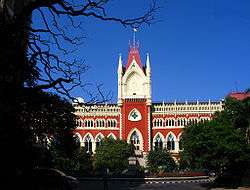Calcutta High Court
| Calcutta High Court কলকাতা উচ্চ আদালত | |
|---|---|
|
Calcutta High Court Building | |
| Established | 1 July 1862 |
| Country |
|
| Location |
Kolkata, West Bengal (Principal Seat) Port Blair (circuit bench) |
| Coordinates | 22°34′6″N 88°20′36″E / 22.56833°N 88.34333°ECoordinates: 22°34′6″N 88°20′36″E / 22.56833°N 88.34333°E |
| Composition method | Presidential with confirmation of Chief Justice of India and Governor of respective state. |
| Authorized by | Constitution of India |
| Decisions are appealed to | Supreme Court of India |
| Judge term length | Till 62 years of age |
| Number of positions | 32 |
| Website | calcuttahighcourt.nic.in |
| Chief Justice | |
| Currently | Hon'ble Justice Mr. Girish Chandra Gupta |
| Since | 21 September 2016 |
The Calcutta High Court is the oldest High Court in India. It has jurisdiction over the state of West Bengal and the Union Territory of the Andaman and Nicobar Islands. The High Court building's design is based on the Cloth Hall, Ypres, in Belgium.[1]
The court has a sanctioned judge strength of 63.
History
The Calcutta high Court is one of the three High Courts in India established at the Presidency Towns by Letters patent granted by Her Majesty Queen Victoria, bearing date June 26, 1862, and is the oldest High Court in India. It was established as the High Court of Judicature at Fort William on July 1, 1862 under the High Courts Act, 1861, which was preceded by the Supreme Court of Judicature at Fort William.
Despite the name of the city having officially changed from Calcutta to Kolkata in 2001, the Court, as an institution retained the old name. The bill to rename it as Kolkata High Court was approved by the Cabinet on July 5, 2016 alongside renaming of its two other counterparts in Chennai and Mumbai[2] However, the High Court still retains the old name.
Principal seat and benches
The seat of the Calcutta High Court is at Kolkata, capital of West Bengal. As per the Calcutta High Court (Extension of Jurisdiction) Act, 1953, the Calcutta High Court's jurisdiction was extended to cover Chandernagore (now called Chandannagar) and the Andaman and Nicobar Islands as of 2 May 1950. The Calcutta High Court extended its Circuit Bench in Port Blair, the capital of the Andaman and Nicobar Islands and in Jalpaiguri, the headquarters of the Jalpaiguri division of West Bengal.
Chief Justice
The current acting Chief Justice is Girish Chandra Gupta.
Barnes Peacock was the first Chief Justice of the High Court. He assumed the charge when the court was founded on 1 July 1862. Romesh Chandra Mitter was the first Indian officiating Chief Justice and Phani Bhushan Chakravartti was the first Indian permanent Chief Justice of the court. The longest serving Chief Justice was Sankar Prasad Mitra.
On 20 September 1871, the acting Chief Justice, John Paxton Norman, was murdered on the steps of the courthouse by Wahabi Muslims.[3]
List of Chief Justices
For Chief Justices of the previous Supreme Court of Bengal see Supreme Court of Judicature at Fort William
| Chief Justice | Term |
|---|---|
| Sir Barnes Peacock | 1862–1870 |
| Richard Couch | 1870–1875 |
| Richard Garth | 1875–1886 |
| William Comer Petheram | 1886–1896 |
| Francis William Maclean | 1896–1909 |
| George Claus Rankin | 1926–1934 |
| Harold Derbyshire | 1934–1946 |
| Arthur Trevor Harries | 1946–1952 |
| Phani Bhusan Chakravartti (First Indian Chief Justice in Calcutta High Court) | 1952–1958 |
| Kulada Charan Das Gupta | 1958–1959 |
| Surajit Chandra Lahiri | 1959–1961 |
| Himansu Kumar Bose | 1961–1966 |
| Deep Narayan Sinha | 1966–1970 |
| Prasanta Bihari Mukharji | 1970–1972 |
| Sankar Prasad Mitra | 1972–1979 |
| Amarendra Nath Sen | 1979–1981 |
| Sambhu Chandra Ghose | 1981–1983 |
| Samarendra Chandra Deb | January 1983 – February 1983 |
| Satish Chandra | 1983–1986 |
| Anil Kumar Sen | September 1986 – October 1986 |
| Chittatosh Mookerjee | 1 November 1986 – 1 November 1987 |
| Debi Singh Tewatia | 1 November 1987 – 1988 |
| Prabodh Dinkarrao Desai | 1988–1991 |
| Nagendra Prasad Singh | 4 February 1992 – 14 June 1992 |
| Anandamoy Bhattacharjee | 1992–1994 |
| Krishna Chandra Agarwal | 1994–1996 |
| V. N. Khare | 2 February 1996 – 20 March 1997 |
| Prabha Shankar Mishra | 1997–1998 |
| Ashok Kumar Mathur | 22 December 1999 – 6 June 2004 |
| V. S. Sirpurkar | 20 March 2005 – 11 January 2007 |
| Surinder Singh Nijjar | 8 March 2007 – 16 November 2009 |
| Mohit Shantilal Shah | 2009–2010 |
| Jainarayan Patel | 2010–2012 |
| Arun Kumar Mishra | 2012–2014 |
| Manjula Chellur | 2014– 2016 |
| Girish Chandra Gupta | 2016– |
The building
The neo-Gothic High Court building was constructed in 1872, ten years after the establishment of the court itself. The design, by then government architect Walter Granville, was loosely modelled on the 13th-century Cloth Hall at Ypres, Belgium.[4]
Jurisdiction question
During 2010, over six decades after India's independence, a curious if swiftly quashed[5] legal debate questioned whether the court was still technically under the jurisdiction of the Queen of the United Kingdom rather than the Indian state.
References
- ↑ Court's official website
- ↑ Change of name of Madras, Bombay and Calcutta HC
- ↑ Ivermee, Robert. Secularism, Islam and Education in India, 1830–1910.
- ↑ Court's official website
- ↑ Jurisdiction Question reported in the Economic Times of India
| Wikimedia Commons has media related to Calcutta High Court. |
